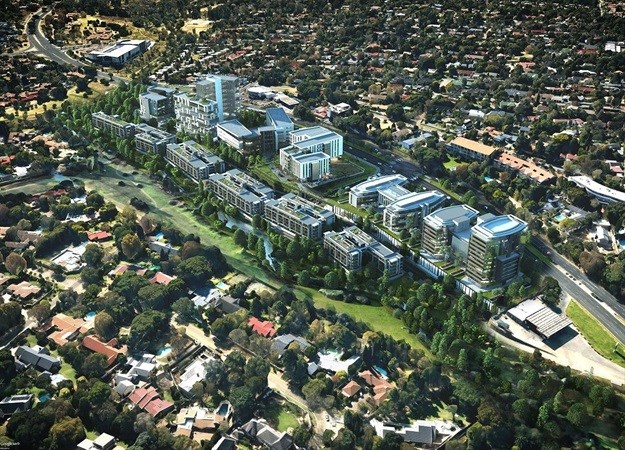Developers of the Sandton Gate mixed-use development Abland and Tiber are targeting a Green Star certification for the whole precinct under the Green Building Council South Africa's (GBCSA) new Green Star Sustainable Precincts tool. Each commercial building in the precinct will be required to attain a minimum four-star Green Star rating for the building itself.
“It is crucial that cities grow in a sustainable manner,” says Marloes Reinink, founder and director of Solid Green, the green building consultant on Sandton Gate. “Cities today face numerous challenges, but at the same time they are nodes of opportunity to move green design beyond the building scale into the public realm.”

Sandton Gate render. Boogertman + Partners
Currently, the precinct is intended to accommodate 80,000m2 of commercial space, 400 residential units, and a variety of lifestyle and leisure amenities. The first phase will break ground towards the end of 2017, and will include all necessary infrastructure, 12,800m2 of P-grade office space, 140 residential units, a gym and recreational spaces.
Sustainable design principles
In order for Sandton Gate to meet the necessary Green Star requirements, a number of factors needed to be considered during the design, construction, and operational phases of the project. Laetitia Cook, Abland’s Green Star accredited professional, says, “It starts with sustainable design principles being applied at a neighbourhood scale. It’s all about creating healthy places to live, work, shop and relax in. The aim is to enrich one’s experience of an area by considering such aspects as diversity, connectivity (modes of transport as well as smart technology), security, art, pedestrianisation, permeability, and well-managed public open spaces with opportunities for outdoor activities and entertainment. This has to be done whilst reducing the ecological footprint of the development to make it environmentally sustainable.”
The Green Star Sustainable Precincts Tool is based on the understanding that buildings do not exist in isolation, but are connected to their surrounding contexts by space, form, their construction processes and the operational impacts over their lifespans. They therefore have the potential to contribute positively to the public realm and the quality of urban dwellers’ experiences.
Creating more sustainable neighbourhoods
Manfred Braune, GBCSA executive director: certifications, explains, “The vision and focus of the Green Star Sustainable Precincts tool is to create more sustainable neighbourhoods, precincts and communities by focusing on five critical components of urban planning, design and construction, namely governance, liveability, economic prosperity, environment and innovation. The tool provides a framework for neighbourhood scale projects to align themselves to, and obtain third party validation of their sustainable development credentials, according to international best practice that is locally relevant.”

Sandton Gate render. Boogertman + Partners
Reinink explains that the tool’s ‘governance’ category seeks to encourage and recognise developments that demonstrate leadership within the sector through the establishment and maintenance of strong governance practices by promoting engagement, transparency, and community and industry capacity building, while striving to ensure that community developments are resilient to a changing climate.
Under ‘liveability’, developments are encouraged to deliver safe, accessible and culturally rich communities. The category encourages the development of healthy and active lifestyles, and rewards communities that have a high level of amenity, activity, and inclusiveness.
The ‘economic prosperity’ category incentivises projects that have access to local and diverse employment, affordable living and housing, investment in education and skills development, and the facilitation of community capacity building. It also promotes greater productivity via emerging opportunities in the digital economy.
The ‘environment’ category strives to reduce the impact of urban development on sensitive ecosystems. It encourages resource management and efficiency by promoting infrastructure, transport and buildings with reduced ecological footprints.
“Projects may also apply for credits under ‘innovation’ by deploying various unique precinct-wide sustainability initiatives that are truly innovative and are not already covered within the tool – for example providing real-time, site-wide leak detection and monitoring systems for all potable water sources, developing innovative approaches to carbon accounting; proposing integrated future thinking technologies into their planning solutions, and reducing construction waste to landfill,” Reinink adds.
































